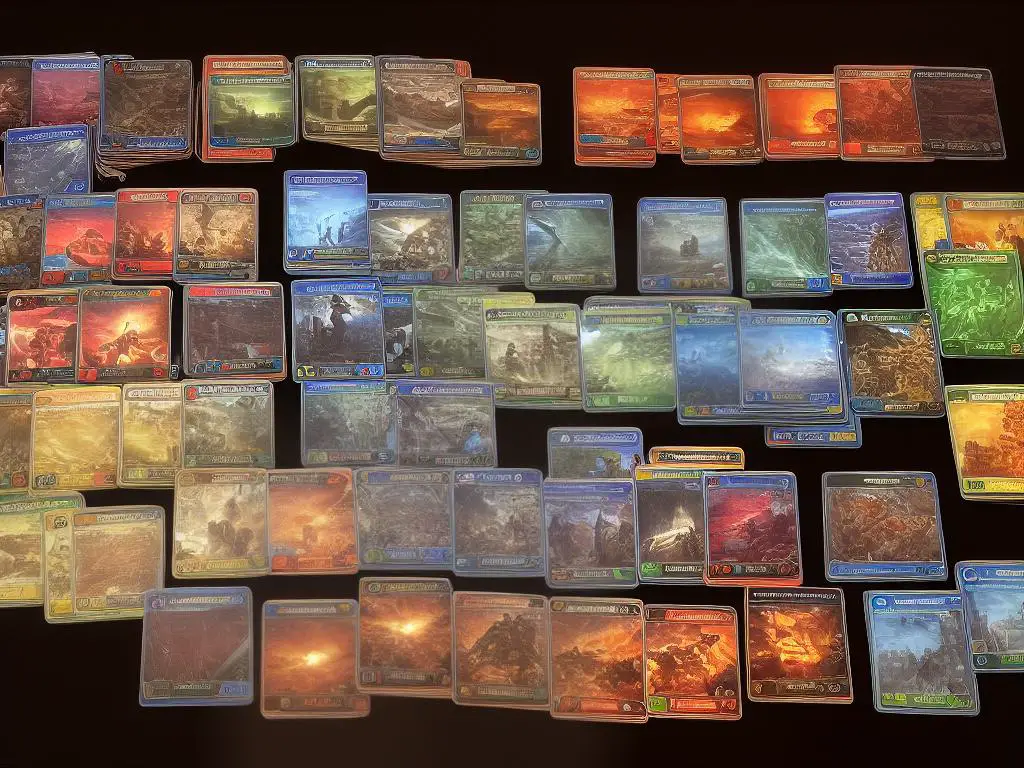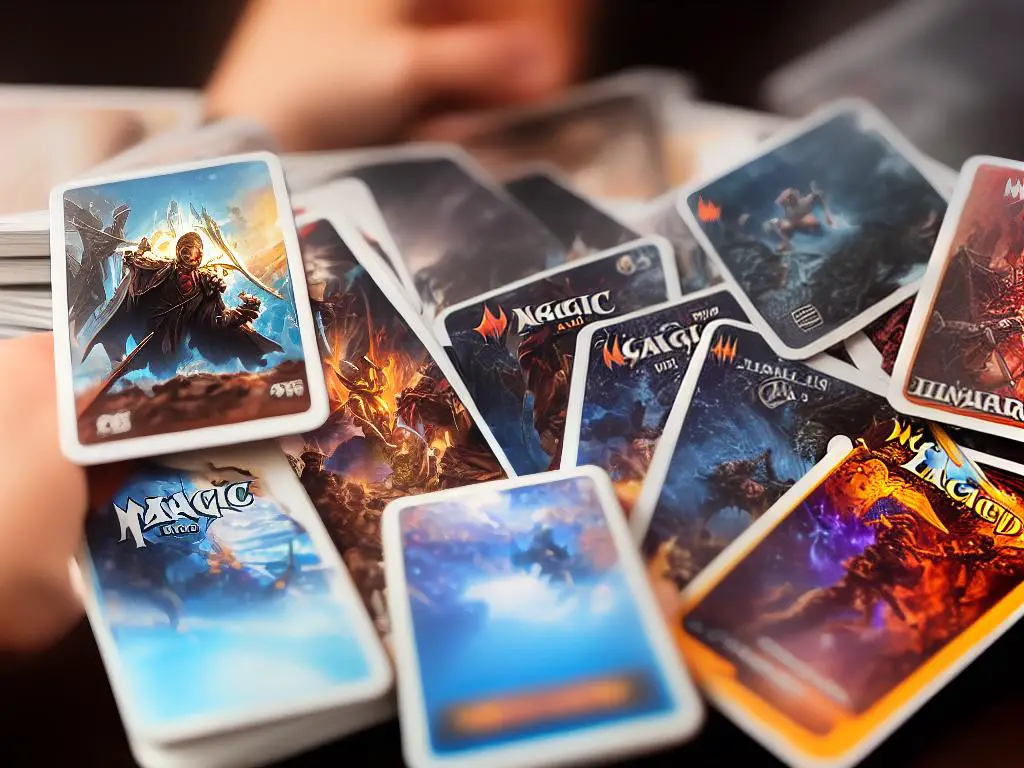Since its inception in 1993, Magic the Gathering (MTG) has captivated the minds and imaginations of millions of fans worldwide, forging an indelible mark in the annals of gaming history. Conjured into existence by Dr. Richard Garfield and nurtured by Wizards of the Coast, this collectible card game’s meteoric rise to prominence is a tale of revolutionary game mechanics, iconic cards, thrilling pro events, and far-reaching cultural impact that transcends the tabletop.
The Creation of Magic the Gathering
Magic: The Gathering (MTG) is a collectible card game that originated in 1993 and took the gaming world by storm. Its creation can be credited to Dr. Richard Garfield, a mathematician, and game designer who conceived the idea while he was still a graduate student at the University of Pennsylvania. The game boasted a mix of strategy, tactics, and chance in a way that had never been seen before. With the flexibility to build personal decks from a vast pool of cards, each with unique illustrations and mechanics, MTG garnered an extensive and loyal fan base around the world.
Behind the publication and distribution of MTG is the company Wizards of the Coast (WotC). This game-publishing company was founded in 1990 by Peter Adkison, an avid game enthusiast himself. At the time, WotC was a small-scale publisher that primarily focused on role-playing games. When Adkison met Garfield at a game convention, he was impressed by Garfield’s innovative concept for a collectible card game. Seeing the potential it held, Adkison decided to take a chance and use his company to publish MTG.
The first edition of Magic: The Gathering, known as Alpha, was released in August 1993 at the Origins Game Fair in Dallas, Texas. Initially, WotC produced a limited print run, not anticipating the enormous success that the game would achieve. The demand for MTG skyrocketed, resulting in the rapid release of additional sets titled Beta and Unlimited, which introduced new card mechanics and expansions to the game. This constant evolution and expansion of the game would eventually become a defining characteristic of MTG that continues to keep it fresh and engaging for players today.
One of the key factors contributing to MTG’s success is its innovative game design. Dr. Garfield’s background as a mathematician and game designer enabled him to create intricate game mechanics and complex strategies for players to explore within the game. Garfield drew inspiration from multiple sources, including traditional card games like bridge, as well as fantasy-themed games like Dungeons & Dragons. Furthermore, MTG was the first game to introduce the concept of a "metagame," wherein players must consider not only their strategies during individual games but also adapt their decks and tactics depending on the broader context of the playing environment.
Magic: The Gathering (MTG) is a collectible card game created in 1993 by mathematics professor Richard Garfield and published by Wizards of the Coast. The game has evolved over time, with numerous expansions and rules updates. At its core, MTG is a strategy game where players use personalized decks filled with cards representing lands, creatures, spells, and artifacts. Each card possesses a unique ability and is used to strategically defeat their opponent by reducing their life total from 20 to 0 or through other victory conditions.

Gameplay and Mechanics
Another notable aspect of Magic: The Gathering history is its impact on the gaming industry. MTG’s immense success sparked a wave of interest in collectible card games, paving the way for numerous other games like Pokémon and Yu-Gi-Oh! that have captured the hearts of millions of fans worldwide. Additionally, the game’s growth spurred the expansion of Wizards of the Coast, which was acquired by Hasbro in 1999. The company has since continued to oversee the development and distribution of Magic: The Gathering, using its extensive resources to maintain and support the game’s ever-expanding player base.
One of the fundamental aspects of MTG is the use of mana as a resource. Mana is generated by ‘tapping’ land cards in play; each land generates one mana of a specific color (white, blue, black, red, or green). Players need to manage their mana efficiently to cast spells or summon creatures from their hand to the battlefield. The ‘mana curve’ represents the balance of cards with different mana costs in a deck, which is essential to ensure that players can cast spells consistently throughout a game.
As the game has evolved, several rule changes and additions have been introduced to streamline gameplay and make it more enjoyable for players. One such change was the ‘Sixth Edition’ rules update in 1999, which introduced important concepts like ‘the stack’ and ‘phases.’ The stack allows players to respond to spells and effects on the battlefield by casting ‘instant’ spells or activating abilities. This system ensures a fair and interactive gameplay by giving both players opportunities to influence the game state. Phases, on the other hand, give structure to the turn order of the game, guiding players through the process of untapping cards, drawing cards, casting spells, and attacking with creatures.
Battles between creatures are central to MTG’s gameplay. When a creature is summoned, it generally cannot attack until the player’s next turn due to ‘summoning sickness.’ Attacking creatures are declared individually or as a group, and the defending player can choose to block with their own creatures or take the damage to their life total. Each creature has a power and toughness statistic, which is often balanced by their mana cost. A creature’s power indicates the damage it can deal, and its toughness represents the amount of damage it can take before being destroyed. Creature interactions, such as blocking, removal spells, or combat tricks, add depth and strategy to the game.
Throughout its history, Magic the Gathering (MTG) has introduced a plethora of keywords and mechanics that add depth and excitement to the game, beyond the core mechanics of casting spells and engaging in creature combat. One such development was the introduction of ‘Planeswalker’ cards in 2007, which represent powerful allies that players can summon during a match. Planeswalkers possess unique abilities that can be activated once per turn by adjusting loyalty counters, offering a range of powerful options. Other intriguing mechanics, like Flying, Vigilance, Lifelink, and Deathtouch, contribute to the versatility of creatures and spells, allowing players to explore infinite strategic possibilities in both deckbuilding and gameplay.

Photo by thaliakarr on Unsplash
Iconic Cards and Expansions
A defining milestone in Magic the Gathering history was the launch of the Alpha set in August 1993. This inaugural set featured several iconic cards that have significantly influenced the trajectory of MTG. Among these iconic cards were the Power Nine, a collection of the most potent cards ever printed in the game, including the Black Lotus, Moxen, Timetwister, Time Walk, and Ancestral Recall. The Power Nine are notable not only for their formidable abilities but also for their minimalist design. Comprising 295 cards, the Alpha set established the essential concepts and mechanics that have persistently served as the backbone of Magic the Gathering.
In 1997, the Saga of the Urza’s block began with the release of Urza’s Saga, an expansion set that further changed the course of Magic history. This block consisting of Urza’s Saga, Urza’s Legacy, and Urza’s Destiny was known for breaking new ground and introducing powerful cards, including Tolarian Academy and Yawgmoth’s Will. However, this set was infamous for being unbalanced in terms of mechanics and power levels that it led to multiple bannings in competitive play. Urza’s block, despite its controversy, had a major impact on the game’s meta and pushed the boundaries of what Magic as a game could entail.Fast forward to 2003, the release of Mirrodin set, a powerful artifact-themed expansion, pushed the boundaries of MTG design and led to some of the most overpowered cards in the game’s history. The infamous artifact lands and affinity mechanic combined to create massive card advantage, enabling some of the fastest combo kills in the history of competitive play. The Mirrodin block was also of particular note for featuring the introduction of Equipment cards, which have become a staple card type in the Magic the Gathering universe.Ravnica: City of Guilds expansion, released in 2005, brought numerous innovations to the game. Primarily focused on multicolor cards and mechanics, the set introduced a uniquely organized structure that was themed around ten factions, or ‘guilds,’ each representing a specific color pair. Characters such as Shockland and Signet helped to shape the future of multicolor Magic, while the guild-specific mechanics made their mark as fan favorites. This expansion had a vibrant backdrop and a new approach to building sets around flavorful factions. The Ravnica block is renowned for its lasting impact on the game and is considered one of the greatest hits in Magic’s long history.The 2010 release of the Scars of Mirrodin block brought Magic: The Gathering into new territory, as it showcased the ongoing war between the natural world of Mirrodin and its metallic counterpart, New Phyrexia. Combining storyline, innovative design, and nostalgia, Scars of Mirrodin delivered a set that resonated with players who had fallen in love with the world-building of Mirrodin and eagerly awaited to see how the conflict unfolded. The cards, such as Mox Opal, Phyrexian Crusader, Wurmcoil Engine, and Koth of the Hammer, were regarded as powerhouses in the game’s meta. This set reimagined the way players approached mechanics and synergies, ensuring Magic’s ability to consistently evolve, grow, and captivate its audience’s imagination.

The Rise of the Pro Tour and Grand Prix Circuit
As Magic: The Gathering (MTG) expanded, the first Pro Tour in 1996 marked a historic milestone in its history. This pioneering event paved the way for large-scale tournaments with significant prize pools. Held in New York City, the initial Pro Tour featured 239 players from 18 countries, boasting $50,000 in prizes. Olle Råde of Sweden emerged as the first Pro Tour champion, sparking a tradition of global competition that persists to this day. Over time, the Pro Tour and its prize pool grew, culminating in select tournaments offering up to $250,000, with a total of $3.5 million awarded during the 2018 season.Parallel to the rise of the Pro Tour was the emergence of the Grand Prix circuit. Established in 1997, these large, open-entry tournaments provided players with opportunities to earn Pro Points, which determined Pro Tour invitations and Pro Club levels. The Grand Prix circuit quickly grew in popularity, offering players a competitive, but accessible avenue to compete in Magic. Over the years, the circuit has adapted to accommodate the growing player base, becoming an essential component of the competitive Magic landscape.Many noteworthy players carved their names in MTG history through their achievements in Pro Tours and Grand Prix events. Jon Finkel, widely considered one of the greatest players of all time, has accrued numerous victories and top finishes across both circuits. Kai Budde, known as the “German Juggernaut,” dominated the pro scene during the early 2000s, setting a high standard for professional play. As the game expanded globally, stars such as Paulo Vitor Damo da Rosa of Brazil, Shota Yasooka of Japan, and Gabriel Nassif of France have each made remarkable contributions to the competitive community.Throughout its history, the Magic pro scene has evolved to reflect shifting formats, policies, and even integration with digital platforms. The introduction of the Magic Online Championship Series (MOCS) in 2005 allowed players to compete professionally through MTG’s online client. The World Championship, which began in 1994, transitioned from a singular global event to a smaller, more elite tournament featuring the 16 best players from around the world. This event now showcases the best from both the paper and digital games, with competitors qualifying through a combination of paper and online events.In recent years, Magic’s competitive scene has continued to grow and globalize. The Magic Pro League (MPL) was introduced in 2019, consisting of 32 top-ranked players who compete in weekly online matches and larger tournaments. Additionally, the introduction of MTG Arena has led to the creation of the Arena Mythic Championships, further integrating digital and paper Magic. As the game celebrates its 27th year, the professional community remains a testament to its enduring appeal and continued expansion.

MTG’s Impact on Popular Culture and Gaming
Magic the Gathering (MTG), created in 1993 by mathematics professor Richard Garfield, has had a massive impact on popular culture and has become a cornerstone in the development of the collectible card game (CCG) genre. MTG popularized the concept of trading and collecting cards while also providing a strategic gameplay experience. Its success led to a surge in the number of CCGs, effectively creating an entire market for this new type of game. Today, there are a multitude of CCGs available, with some of the most notable being Pokémon, Yu-Gi-Oh!, and Hearthstone. The success of these games can largely be attributed to the trailblazing impact of MTG, which maintains its influential status through competitive events like the MPL and Arena Mythic Championships.
.
The influence of Magic the Gathering extends beyond the realm of physical card games and into the digital sphere as well. Digital and video games have borrowed elements from MTG in various forms, from gameplay mechanics to art styles. Hearthstone, an online CCG developed by Blizzard Entertainment, is an excellent example of a game that takes many core elements from MTG, such as strategic decision-making, deck-building, and turn-based gameplay. MTG itself has seen several digital iterations, including Magic the Gathering Online, Magic the Gathering Arena, and adaptations for consoles like the popular Magic the Gathering: Duels of the Planeswalkers series.
MTG’s impact on popular culture also stretches into various forms of media, such as literature, television, and film. The lore and characters from the Magic the Gathering universe have spawned an extensive series of novels, expanding the game’s rich mythology beyond the cards themselves. These novels focus on the various planeswalkers and worlds within the MTG multiverse, offering more depth and opportunities for fans to connect with the characters and universe. Television has also seen MTG’s influence, with shows like “Penn & Teller’s Fool Us” featuring card tricks inspired by Magic the Gathering card mechanics.
Recently, it was announced that the Russo brothers, who directed the highly popular Avengers: Endgame and Avengers: Infinity War movies, are working on an animated television series based on the Magic the Gathering lore. This will introduce the characters and stories from the intense card game to a potentially broader audience, further expanding MTG’s reach and impact on popular culture.
As the popularity of Magic the Gathering continues to grow, so does its influence on gaming and popular culture. Thanks to MTG’s successful integration of immersive storytelling with trading and collecting cards, as well as strategic gameplay, an entire genre of gaming and collections has emerged. The enormous impact of MTG is evident in its influence on digital and video games, literature, television, and film, and it stands as a testament to the power of innovation in transforming an industry.

From humble beginnings to global phenomenon, Magic the Gathering’s rich history is a testament to its enduring appeal and the immense creativity of its designers, players, and supporters. As the game continues to evolve and inspire, one thing remains certain: MTG’s legacy in the world of gaming and popular culture will continue to flourish, enchanting countless generations to come, and retaining its rightful place as a cornerstone in the ever-expanding landscape of gaming.
